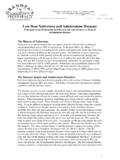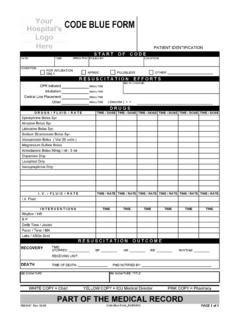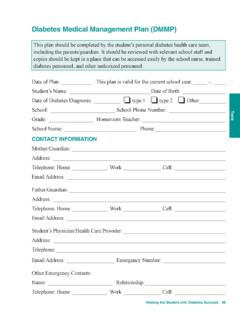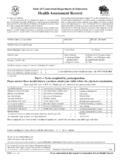Transcription of 2. QUALITATIVE AND QUANTITATIVE COMPOSITION 3 ...
1 NEW ZEALAND DATA SHEET. 1. PRODUCT NAME. BECLAZONE 50 micrograms CFC-Free Inhaler BECLAZONE 100 micrograms CFC-Free Inhaler BECLAZONE 250 micrograms CFC-Free Inhaler (beclometasone dipropionate inhaler, CFC-Free, 50 mcg, 100 mcg and 250 mcg). 2. QUALITATIVE AND QUANTITATIVE COMPOSITION . Each metered dose delivers 50 mcg, 100 mcg or 250 mcg beclometasone dipropionate. Excipient with known effect: ethanol (anhydrous). For the full list of excipients, see section 3. PHARMACEUTICAL FORM. Pressurised inhalation, suspension. 4. CLINICAL PARTICULARS. Therapeutic indications Beclometasone dipropionate provides effective anti-inflammatory action in the lungs and offers preventive background treatment of asthma. Severe asthma requires regular medical assessment as death may occur.
2 Patients with severe asthma have constant symptoms and frequent exacerbations, with limited physical capacity, and PEF. values below 60% predicted at baseline with greater than 30% variability, usually not returning entirely to normal after a bronchodilator. These patients will require high dose inhaled (see section dose and method of administration) or oral corticosteroid therapy. Sudden worsening of symptoms may require increased corticosteroid dosage which should be administered under urgent medical supervision. Adults Prophylactic management in: Mild asthma (PEF values greater than 80% predicted at baseline with less than 20% variability): Patients requiring intermittent symptomatic bronchodilator asthma medication on more than an occasional basis.
3 Moderate asthma (PEF values 60-80% predicted at baseline with 20-30% variability): Patients requiring regular asthma medication and patients with unstable or worsening asthma on other prophylactic therapy or bronchodilator alone. Severe asthma (PEF values less than 60% predicted at baseline with greater than 30% variability): Patients with severe chronic asthma. On transfer to high dose inhaled beclometasone dipropionate, many patients who are dependent on systemic corticosteroids for adequate control of symptoms may be able to reduce significantly or eliminate their requirement for oral corticosteroids. Paediatric population (7-12 years). Any child who requires prophylactic asthma medication (see section dose and method of administration).
4 Version 1. dose and method of administration Patients should be made aware of the prophylactic nature of therapy with inhaled beclometasone dipropionate and that it should be taken regularly even when they are asymptomatic. The dosage of beclometasone dipropionate should be adjusted according to the individual response. If patients find that short-acting relief bronchodilator treatment becomes less effective or they need more inhalations than usual, medical attention must be sought. In patients who find co-ordination of a pressurised metered dose inhaler difficult a spacer device may be used with BECLAZONE CFC-Free Inhaler. The therapeutic effect occurs after a few days' treatment and reaches its maximum after 2-3 weeks. dose Adults and children over 12 years of age Patients should be given a starting dose of inhaled beclometasone dipropionate (BECLAZONE 50.)
5 Micrograms CFC-Free Inhaler or BECLAZONE 100 micrograms CFC-Free Inhaler or BECLAZONE 250 micrograms CFC-Free Inhaler) which is appropriate for the severity of their disease based on the following guidance: Mild asthma: 200 to 600mcg per day in divided doses. Moderate asthma: 600 to 1000mcg per day in divided doses. Severe asthma: Up to 1000mcg per day in divided doses. The dose may then be adjusted until control is achieved or reduced to the minimum effective dose according to the individual response. Paediatric population (7 12 years). Up to 200mcg per day in divided doses. Children should be given a starting dose of inhaled beclometasone dipropionate which is appropriate for the severity of their disease. The dose may then be adjusted until control is achieved or reduced to the minimum effective dose according to the individual response.
6 There are no data on the use of Beclazone CFC-Free Inhaler in children aged under seven years. Method of administration For inhalation use. Special populations There is no need to adjust the dose in elderly patients or in those with hepatic or renal impairment. Contraindications Hypersensitivity to the active substance or to any of the excipients listed in section Special warnings and precautions for use Asthma Management The management of asthma should follow a stepwise programme, and patient response should be monitored clinically and by lung function tests. Increasing use of short-acting inhaled 2 agonists to control symptoms indicates deterioration of asthma control. Under these conditions, the patient's therapy plan should be reassessed.
7 Sudden and progressive deterioration in asthma control is potentially life-threatening and consideration should be given to increasing corticosteroid dosage. In patients considered at risk, daily flow monitoring may be instituted. BECLAZONE CFC-Free Inhaler is not for use in acute attacks but for routine long-term management. Patients will require a fast- and short-acting inhaled bronchodilator to relieve acute asthmatic symptoms. Version 2. Patients' inhaler technique should be checked to make sure that aerosol actuation is synchronised with inspiration of breath for optimum delivery of the medicine to the lungs. Lack of response or severe exacerbations of asthma should be treated by increasing the dose of inhaled beclometasone dipropionate and, if necessary, by giving a systemic steroid and/or an antibiotic if there is an infection.
8 Systemic Effects Systemic effects may occur with any inhaled corticosteroid, particularly at high doses prescribed for long periods; these effects are much less likely to occur than with oral corticosteroids. Possible systemic effects include Cushing's Syndrome, Cushingoid features, adrenal suppression, growth retardation in children and adolescents, decrease in bone mineral density, cataract, glaucoma, blurred vision and more rarely, a range of psychological or behavioural effects including psychomotor hyperactivity, sleep disorders, anxiety, depression or aggression (particularly in children). It is important, therefore, that the dose of inhaled corticosteroid is titrated to the lowest dose at which effective control is maintained (see section Undesirable Effects).
9 Possible systemic effects also include growth retardation in children and adolescents. It is recommended that the height of children receiving prolonged treatment with inhaled corticosteroid is regularly monitored. If growth is slowed, therapy should be reviewed with the aim of reducing the dose of inhaled corticosteroid if possible, to the lowest dose at which effective control of asthma is maintained. In addition, consideration should be given to referring the patient to a paediatric respiratory specialist. Certain individuals can show greater susceptibility to the effects of inhaled corticosteroid than do most patients. Visual disturbance Visual disturbance may be reported with systemic and topical corticosteroid use. If a patient presents with symptoms such as blurred vision or other visual disturbances, the patient should be considered for referral to an ophthalmologist for evaluation of possible causes which may include cataract, glaucoma or rare diseases such as central serous chorioretinopathy (CSCR) which have been reported after use of systemic and topical corticosteroids.
10 Transfer from Systemic Steroids Because of the possibility of impaired adrenal response, patients transferring from oral steroid therapy to inhaled beclometasone dipropionate therapy should be treated with special care, and adrenocortical function regularly monitored. The patient should be in a reasonably stable state before being given beclometasone dipropionate inhaler in addition to his usual maintenance dose of systemic steroid. After about a week, gradual withdrawal of the systemic steroid is started by reducing the daily dose by 1 mg prednisolone, or its equivalent of other corticosteroids, at not less than weekly intervals. Patients treated with systemic steroids for long periods of time or who have received high doses may have adrenocortical suppression.

















